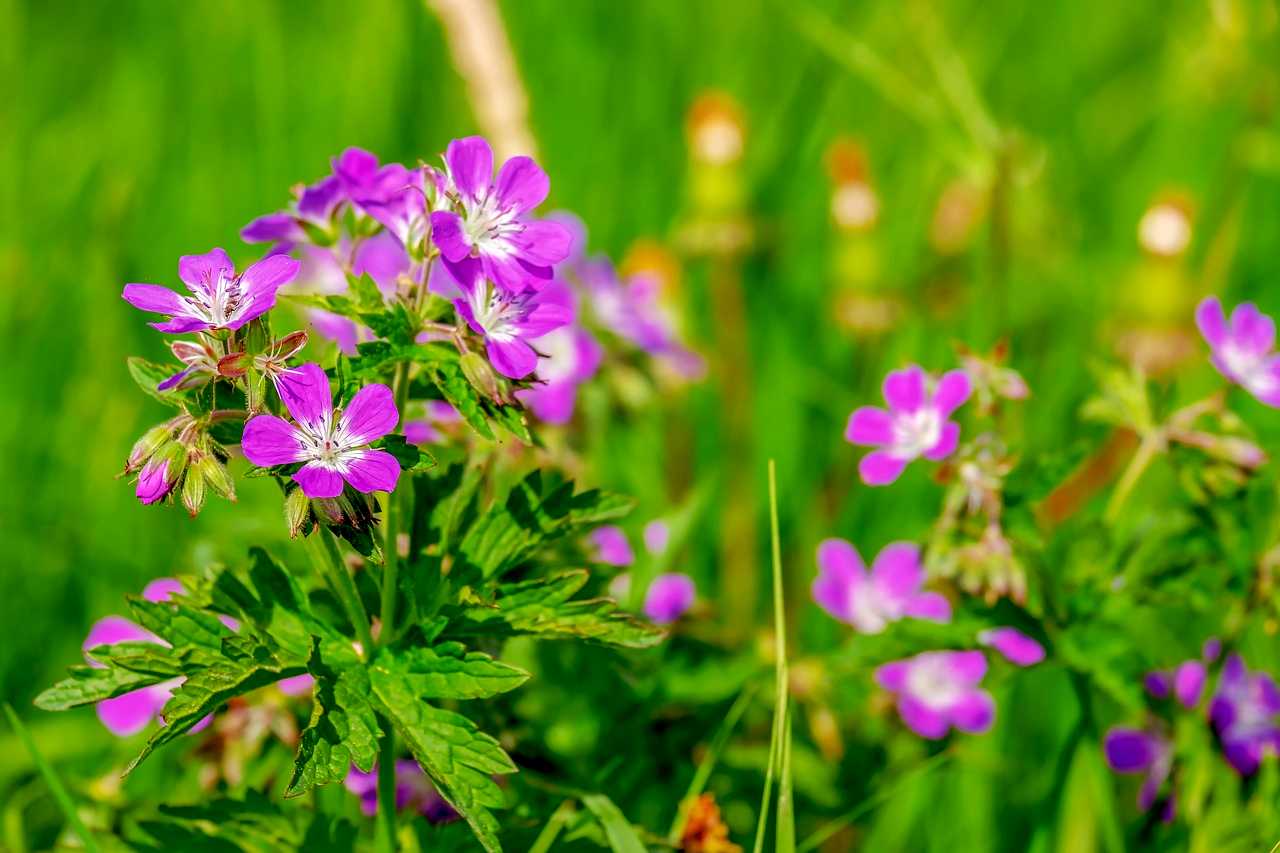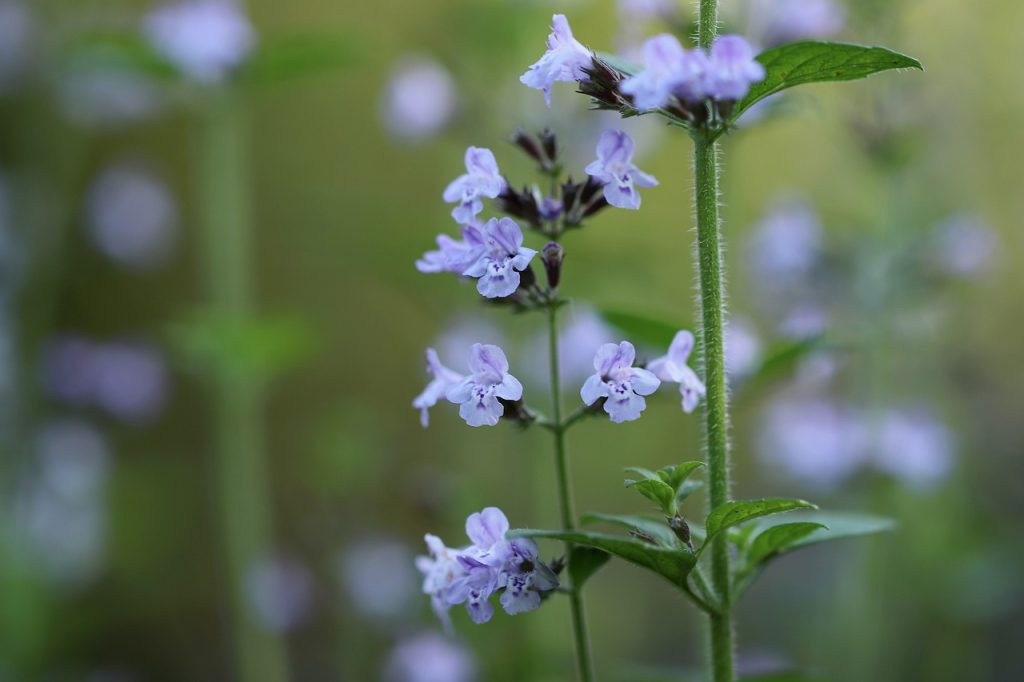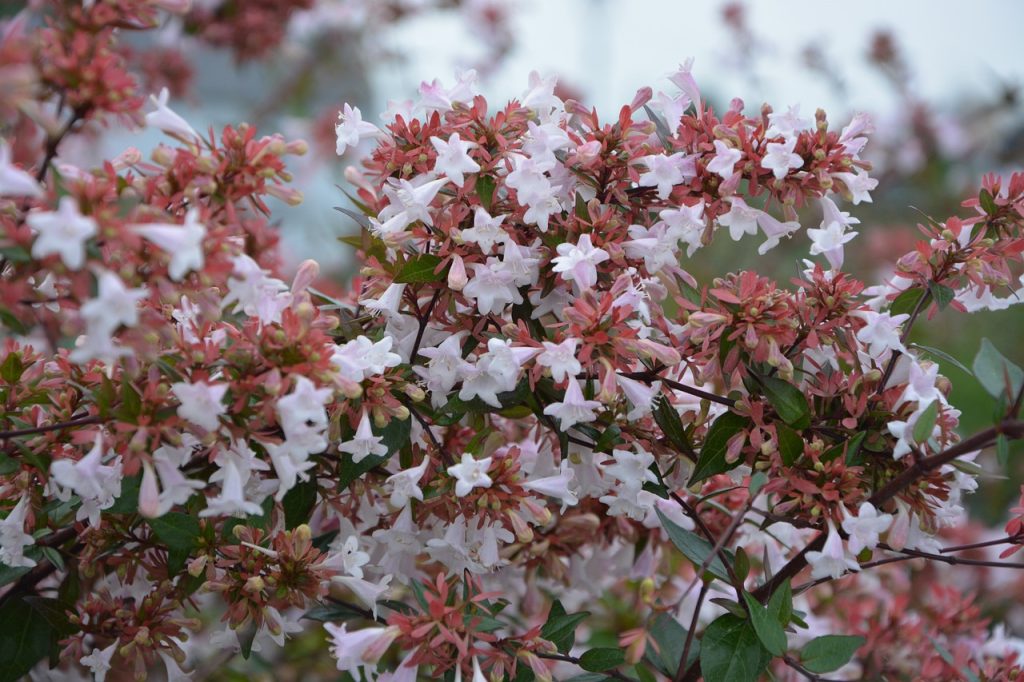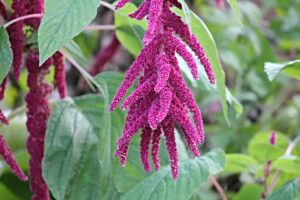As the crispness of fall envelops the garden, it becomes essential to choose plants that thrive with less intervention. Here are a wide assortment of exceptional, low-maintenance options for your autumn landscape:
Ajuga
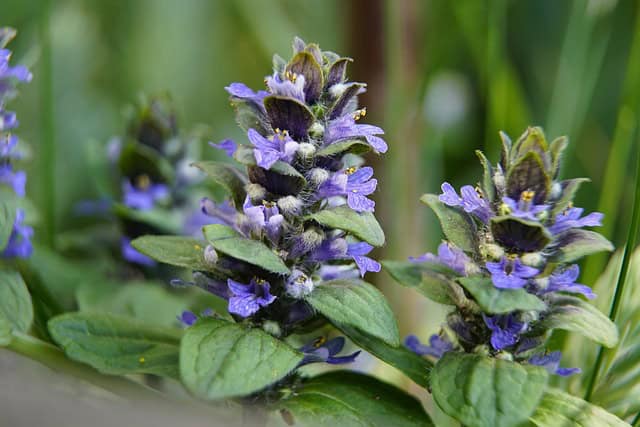
Ajuga, commonly known as Bugleweed, stands out as a remarkable ground cover with its vibrant foliage and delightful flowers. This perennial boasts earthen tones of green, purple, and bronze, which provide a stunning contrast against the autumn backdrop.
One of the most appealing aspects of Ajuga is its adaptability; it flourishes in a variety of lighting conditions, from full sun to full shade. This versatility means you can incorporate Ajuga into diverse garden styles, whether as a border plant or within shaded spots under trees. Its low-growing habit, reaching about 6 to 12 inches in height, makes it ideal for suppressing weeds while creating a natural carpet of color.
During the fall, Ajuga showcases its striking blue to purple flower spikes, which can attract pollinators like bees and butterflies even as other blooms begin to fade. In terms of care, Ajuga is drought-tolerant once established and only requires an occasional trim to prevent overcrowding. This makes it a superb choice for those wanting to enjoy a flourishing garden without constant upkeep.
Allium

Allium, often known as ornamental onion, brings an architectural elegance to any garden with its tall, spherical flower heads. While commonly associated with late spring and summer blooms, many varieties of Allium can bloom into the fall, adding a burst of interest just as many other plants begin to fade away.
The striking purple and white blooms of Allium can reach heights of up to 4 feet, offering a dramatic focal point while remaining remarkably low-maintenance. These robust perennials thrive in well-drained soil and full sun, and once established, they require little to no watering, making them perfect for busy gardeners.
Beyond their visual appeal, Alliums are more than just pretty flowers. They are also exceptionally pest-resistant, warding off many common garden nuisances due to their onion-like scent. This natural defense mechanism reduces the need for chemical treatments, aligning perfectly with eco-friendly gardening practices. Plus, their sturdy stems can withstand fall winds, ensuring that your garden retains its structure even as the seasons change.
Asters
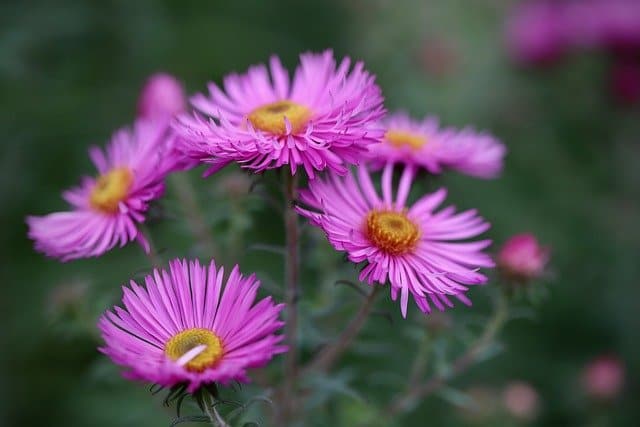
Asters are a quintessential fall staple, providing a splash of color just as most gardens begin their winter hibernation. These perennial plants produce vibrant blooms in shades of purple, pink, blue, and white, creating a stunning display that attracts pollinators like bees and butterflies. What makes Asters particularly appealing is their ability to thrive with little effort on your part.
These hardy plants prefer well-drained soil and full sunlight, yet they can also tolerate a range of conditions, including partial shade. Asters are notably drought-tolerant once established, requiring minimal watering. This resilience makes them perfect for low-maintenance gardeners who want beautiful blooms without the constant fuss.
Asters bloom from late summer into fall, ensuring your garden remains lively during this transition period. Additionally, their fragrant blooms make them an excellent choice for cutting gardens, as they can brighten up indoor spaces as well. In late fall, Asters transition into the landscape with their seed heads providing visual interest and sustenance for birds, further enhancing the ecological value of your garden.
Azalea
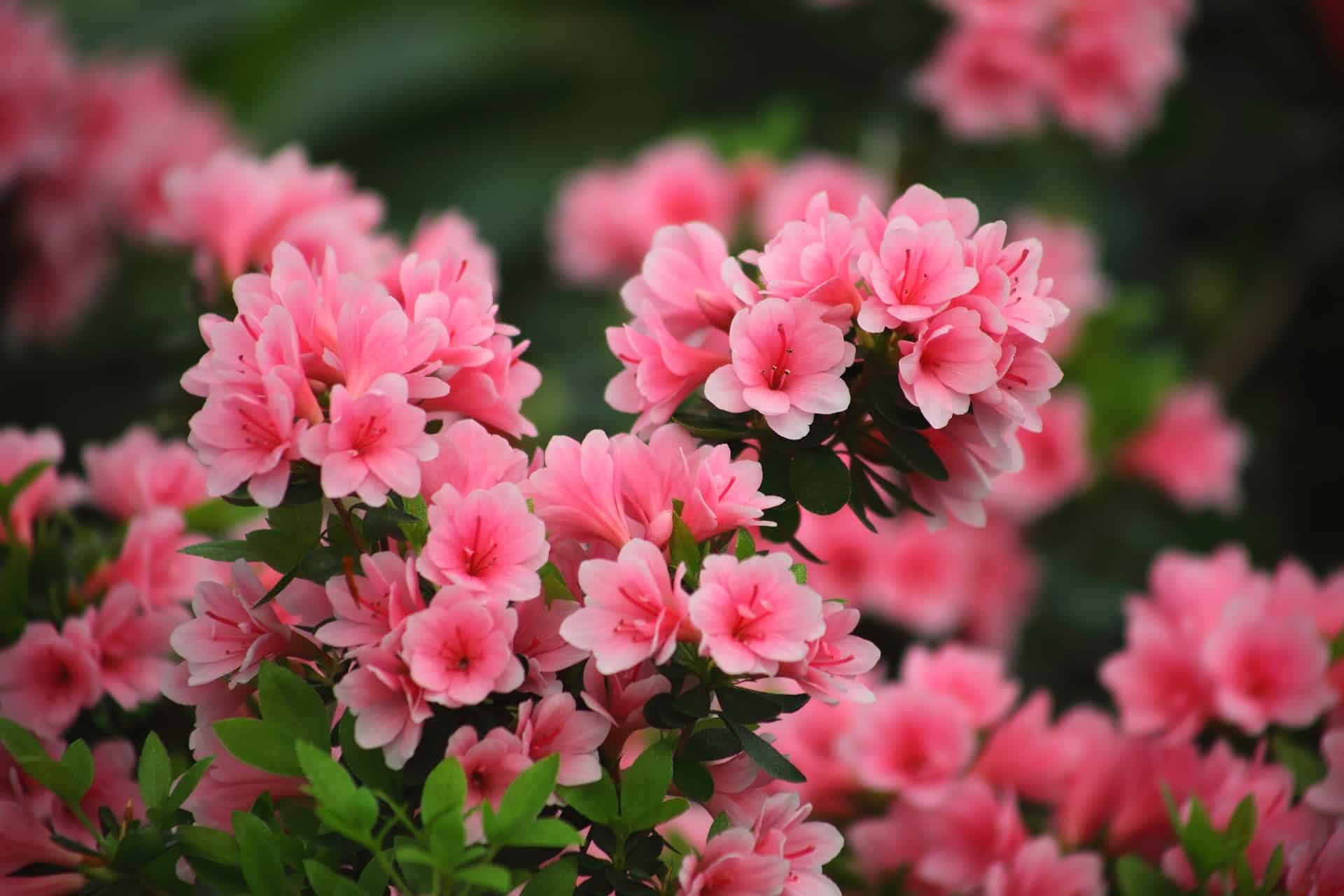
Azaleas, a beloved member of the Rhododendron family, are renowned for their spectacular blossoms and glossy leaves. While they are typically thought of as spring bloomers, many varieties can thrive well into the fall, particularly deciduous species. These shrubs are exceptionally versatile, making them suitable for various garden styles—from informal cottage gardens to formal landscapes.
What sets Azaleas apart as low-maintenance fall plants is their relatively easy care requirements. They prefer acidic, well-drained soil and can tolerate partial shade, making them ideal for those tricky spots that receive filtered sunlight. Established Azaleas are surprisingly drought-resistant, allowing them to endure dry spells without constant watering.
During the fall, Azaleas can still maintain their attractiveness as their leaves shift into rich autumnal hues. While the blooms may fade, the deep greens and bronzed leaves provide texture and visual interest in the garden. To keep these beauties thriving, a simple biannual pruning and occasional mulching to retain moisture will ensure their longevity and health, making Azaleas a fantastic choice for a low-maintenance garden.
Beautyberry
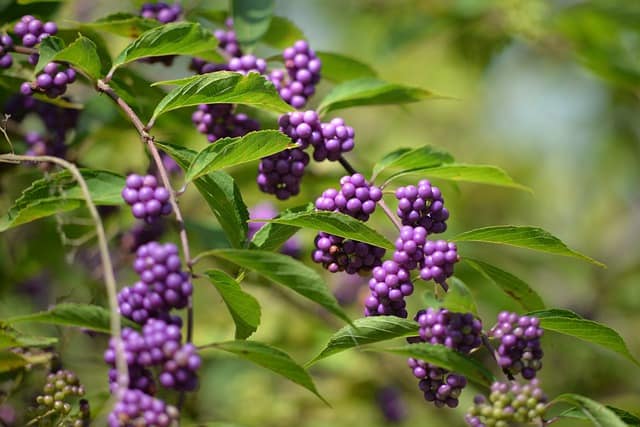
Beautyberry (Callicarpa), known for its striking clusters of vibrant purple berries, is a stunning addition to any fall landscape. This deciduous shrub offers a unique visual appeal that stands out among traditional fall foliage. As the leaves change colors to shades of yellow and orange, the bright berries emerge, providing a spectacular contrast that draws the eye.
One of the finest features of Beautyberry is its forgiving nature in various soil types. These resilient plants adapt well to both dry and average moisture conditions, making them suitable for a wide range of garden scenarios. They thrive in full sun to partial shade, allowing gardeners to place them in diverse areas without worrying about performance.
Beautyberry is also a great conversation starter due to its fascinating wildlife interactions. The berries not only provide food for birds — such as mockingbirds and sparrows — but they also make excellent cut stems for fall arrangements. With minimal requirements for care, just the occasional pruning to control shape and size is needed, allowing you to enjoy its rugged beauty with minimal effort.
Bee Balm
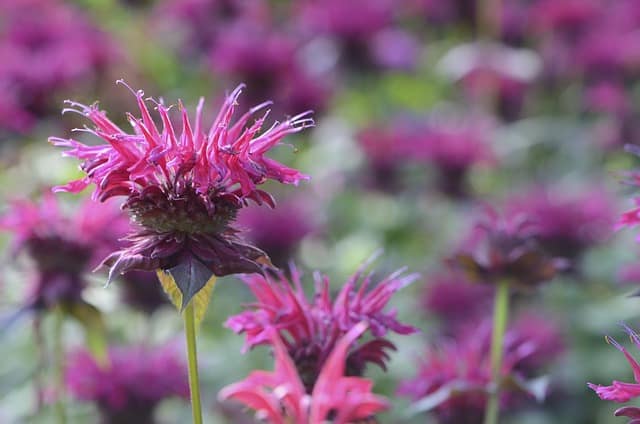
Bee Balm (Monarda), also known as Oswego tea or bergamot, is a standout choice for fall gardens thanks to its eye-catching, tubular flowers that bloom in shades of vibrant red, pink, and purple. These flowers are not only a feast for the eyes but also a magnet for pollinators, including bees, butterflies, and hummingbirds, enhancing the biodiversity of your garden space.
In addition to its stunning visual appeal, Bee Balm is incredibly adaptable and easy to grow. It thrives in rich, well-drained soil and can flourish in full sun to partial shade. Once established, Bee Balm is drought-tolerant, making it an ideal candidate for gardeners who prefer a low-maintenance option. It’s worth noting that this plant’s resilience to heat and humidity makes it particularly suitable for warmer climates.
Beyond its ornamental value, Bee Balm is also appreciated for its aromatic leaves, which can be harvested for culinary uses or herbal teas. A simple pruning after flowering can help maintain its shape and encourage new growth in the following season, ensuring that this culinary and pollinator-friendly plant continues to thrive in your garden year after year.
Betony
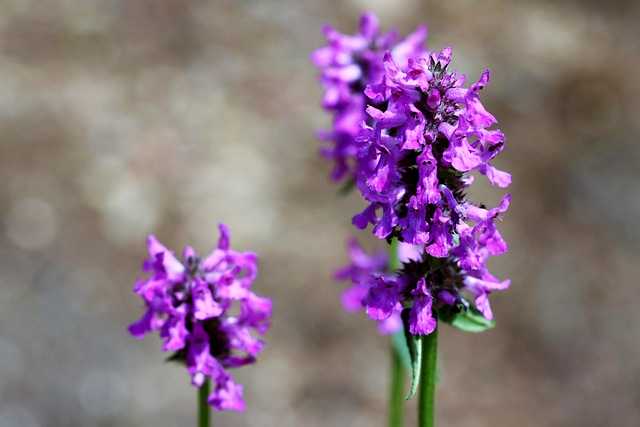
Betony (Stachys), often referred to as woundwort, is a delightful perennial that adds texture and charm to any fall garden. This hardy plant features spikes of purple or pink flowers atop sturdy stems, creating an enchanting show in the late summer and early fall. Its dense, wrinkled leaves form a lush green carpet that can provide a lovely backdrop for other seasonal plants.
One of Betony’s outstanding characteristics is its remarkable adaptability. It thrives in a range of soil conditions, including clay and sandy types, and can tolerate both full sun and partial shade. Once it is established, Betony requires little water and minimal maintenance, making it an excellent choice for busy gardeners.
Furthermore, Betony’s flowers attract a variety of pollinators, contributing to a healthy garden ecosystem. Its resilience also makes it resistant to deer and rabbits, reducing the likelihood that your hard work will be undone by hungry critters. A simple cutting back after flowers fade can help promote bushier growth for the next season, allowing Betony to be a dependable player in your low-maintenance garden.
Elderberry
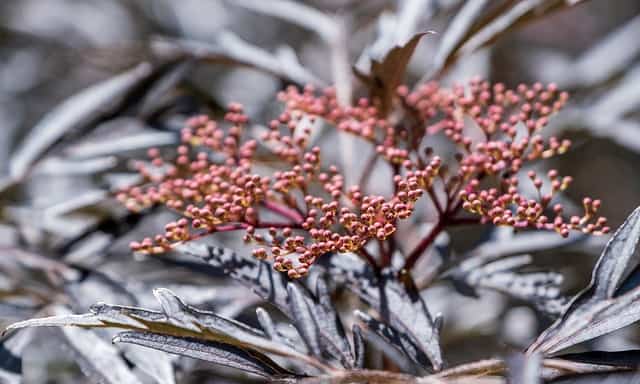
Elderberry (Sambucus) is a versatile and beneficial shrub that brings both beauty and utility to a fall garden. Renowned for its striking clusters of small white flowers in the summer, Elderberry transitions into the fall with deep purple-black berries that provide a stunning contrast against the backdrop of autumn foliage.
This plant thrives in various conditions, favoring moist, well-drained soil and full sun to partial shade. Once established, Elderberry is remarkably resilient, requiring little maintenance beyond an annual pruning to shape and encourage optimal growth. Its ability to tolerate drought once matured makes it an excellent option for gardeners in regions with varied rainfall.
Not only does Elderberry enhance the visual aesthetics of your garden, but it also serves as a vital food source for birds and other wildlife, making it a valuable addition for those looking to support local biodiversity. Moreover, the berries can be harvested and transformed into syrups, jams, or wines, providing not just ornamental value but culinary benefits as well. By incorporating Elderberry into your landscape, you create a thriving habitat while adding a touch of functional beauty to your low-maintenance fall plantings.
Bloody Cranesbill
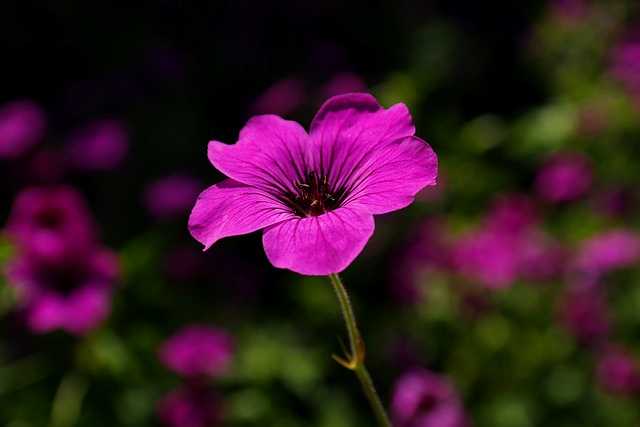
Bloody Cranesbill (Geranium sanguineum) is a perennial favorite that adds a burst of color to the fall garden with its vibrant magenta blossoms. This plant is known for its abundant flowers which can often continue blooming well into the fall, providing a delightful display as the season changes. The attractive foliage, which turns shades of reddish-brown in the fall, contributes to its visual appeal, making it a wonderful choice for garden borders or rock gardens.
One of the most appealing features of Bloody Cranesbill is its adaptability. It thrives in various soil types, from sandy to clay, and can grow successfully in full sun or part shade. Once established, it requires minimal watering and is quite drought-tolerant. This effectiveness against pests and diseases further adds to its low-maintenance nature.
In addition, Bloody Cranesbill is effective at controlling weeds, providing natural ground cover that suppresses unwanted plants while showcasing its own vibrant blooms. A simple deadheading of spent flowers can encourage a second blooming period and maintaining this plant is as easy as performing occasional clean-up in the spring before the new growth begins. By incorporating Bloody Cranesbill into your garden, you can enjoy a lively pop of color with minimal effort.
Blue Holly
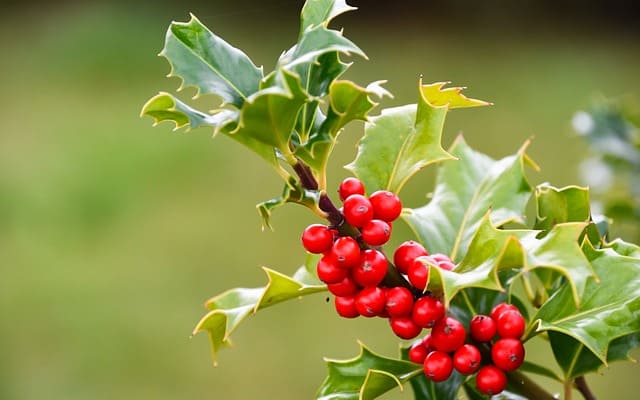
Blue Holly (Ilex meserveae) is an evergreen shrub celebrated for its striking foliage and vibrant berries. As the name suggests, this holly variety showcases glossy, dark green leaves with a blueish hue and spiny edges, providing year-round interest in the garden. In the fall, the female plants bear bright, red berries that not only add a splash of color but also attract birds and other wildlife, creating a lively ecosystem around your garden.
This plant is exceptionally hardy, flourishing in various soil types, including sandy or loamy soils, provided they are well-drained. Blue Holly is resistant to many common pests and diseases, requiring little to no chemical treatments, making it an excellent low-maintenance choice. Once established, these shrubs are drought-resistant, needing only occasional watering, especially during extended dry spells.
Due to its compact growth habit and slow maturation, Blue Holly is an ideal candidate for smaller gardens or as a decorative element in larger landscapes. Pruning is minimal, typically limited to shaping or removing any dead or damaged branches. For those looking for winter interest, Blue Holly is a perfect addition, ensuring your garden remains visually appealing even when most other plants have gone dormant.
Brunnera
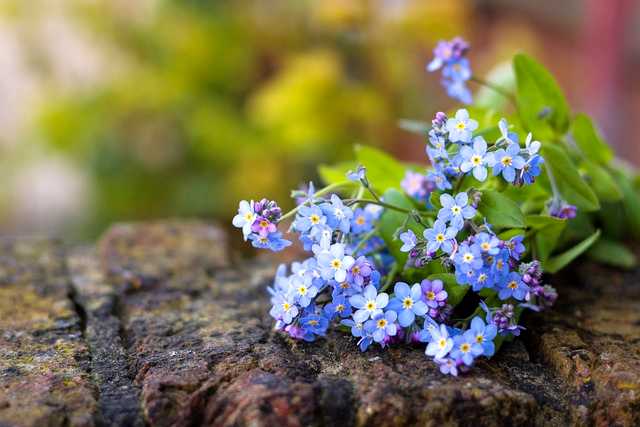
Brunnera, commonly known as Siberian Bugloss or False Forget-Me-Not, is a charming perennial that adds a soft elegance to fall gardens. Known for its heart-shaped leaves and lovely clusters of tiny blue flowers, Brunnera continues to be a favorite among shade gardens and woodland settings. Its foliage, which remains lush and vibrant into the fall, provides an attractive ground cover that pairs beautifully with other fall foliage.
This plant thrives in partial to full shade, making it an excellent option for those less sunny areas of your garden. Brunnera requires little care beyond regular watering during dry spells and enjoys rich, moist soil. It is notably resilient to pests and diseases, ensuring you can enjoy its beauty without the constant worry of maintenance.
In the fall, Brunnera’s leaves often display lovely gold and bronze hues, contributing to the seasonal palette. As the flowers fade, the plant still retains its aesthetic appeal and works well as a companion plant among hostas and ferns, enhancing the lushness of shaded areas. Autumn mulching can beneficially protect the roots while keeping weeds at bay, allowing Brunnera to thrive with minimal intervention.
Calamint
Calamint (Calamintha nepeta) is an aromatic perennial that shines during the fall months, producing delicate, tiny white to pale blue flowers. This wonderful herbaceous plant is not only visually appealing but also boasts culinary and medicinal uses, making it a multi-faceted addition to your garden. The scent of crushed leaves releases a soothing, minty aroma, attracting beneficial insects such as bees and butterflies—perfect for promoting biodiversity in your garden.
Calamint thrives in well-drained soil and enjoys full sun to partial shade, making it flexible and easy to incorporate into various garden styles. Once established, it is highly drought-tolerant, needing little water beyond occasional deep soaks during extended dry spells. Its vigorous growth habit allows it to spread and create lovely ground cover, effectively suppressing weeds and reducing the need for constant weeding.
After blooming in late summer into fall, a simple trim can promote healthier foliage and prepare the plant for winter dormancy. Calamint’s hardy nature means it can withstand colder temperatures while maintaining its cheerful presence in the garden. For those who appreciate both beauty and utility, Calamint is a versatile choice that embodies the spirit of low-maintenance gardening.
Celosia
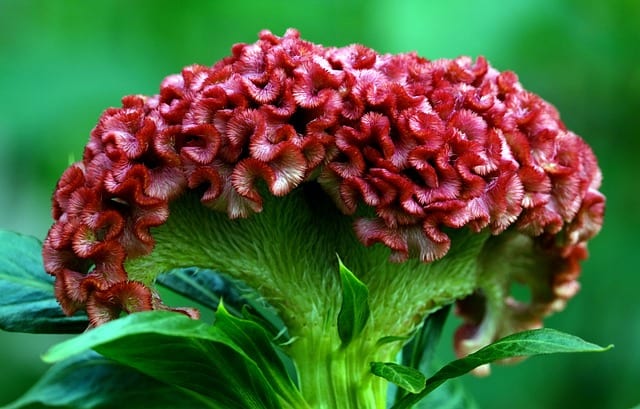
Celosia, commonly known as cockscomb or woolflower, is a striking annual that brings dramatic color and texture to fall gardens. Renowned for its unique flower shapes resembling flames or brain-like formations, Celosia blooms in vibrant shades of red, orange, yellow, and purple, making it a standout choice for adding excitement to your landscape. These bold colors not only enliven your garden but also provide a backdrop for other fall foliage, offering a stunning contrast.
Celosia thrives in full sun and well-drained soil, thriving in hot, dry conditions—qualities that make it particularly low-maintenance for gardeners in warmer regions. This resilient plant is also resistant to pests and diseases, which means fewer worries about chemical treatments. Watering is minimal after establishment, as plants can handle the heat with ease.
One of the most appealing aspects of Celosia is its long-lasting blooms, which can persist well into the fall, maintaining color and visual interest even as temperatures begin to dip. Additionally, many varieties of Celosia are excellent for cutting gardens, as they can be used in floral arrangements, both fresh and dried, extending their beauty indoors. By incorporating Celosia into your autumn garden, you create a lively focal point that delights in its simplicity and vibrant aesthetic.
Chrysanthemums
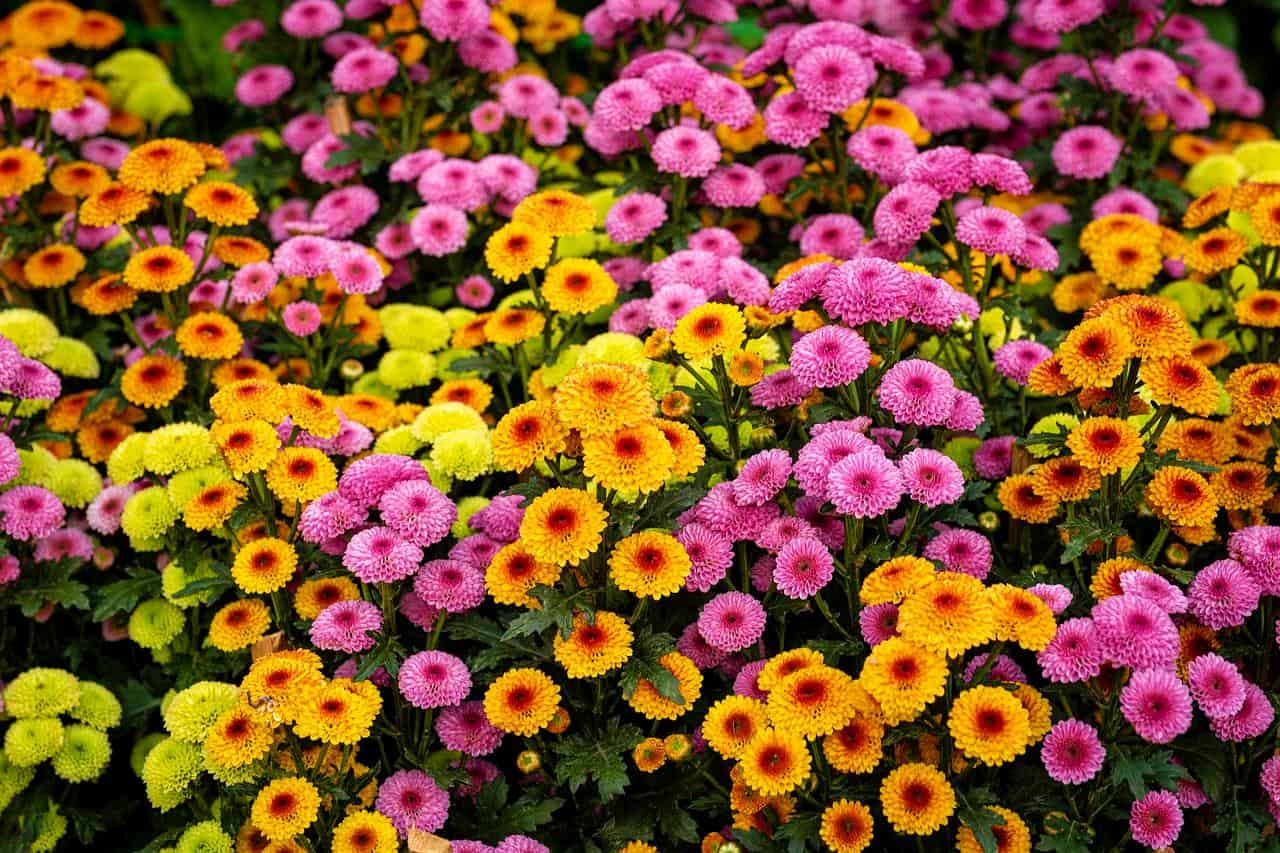
Chrysanthemums, often lovingly referred to as mums, are a quintessential element of fall gardens and are synonymous with autumnal beauty. With a plethora of varieties available, these hardy perennials offer an array of colors, shapes, and sizes, allowing gardeners to create stunning displays that resonate with the season. From bold reds and yellows to delicate whites and purples, the versatility of mum blooms is unmatched, brightening every corner of your garden.
These resilient plants favor full sun and well-drained soil, thriving with minimal care. Once established, Chrysanthemums require little watering, as they are adaptable to various conditions and can endure occasional drought. A little deadheading of spent blooms can encourage further flowering, extending the vibrant display into late fall.
In addition to their delightful appearance, Chrysanthemums often symbolize the beauty and warmth of the season, making them a fantastic choice for seasonal decor. For those who enjoy bringing nature indoors, Chrysanthemums make excellent cut flowers that last in arrangements, creating beautiful displays throughout the home. To ensure these colorful plants return year after year, simply allow their foliage to die back naturally in the fall, followed by a light pruning in the spring to promote fresh growth. By incorporating Chrysanthemums into your low-maintenance fall gardening plan, you can enjoy a dazzling array of colors and textures that celebrate the essence of autumn.
Coneflower
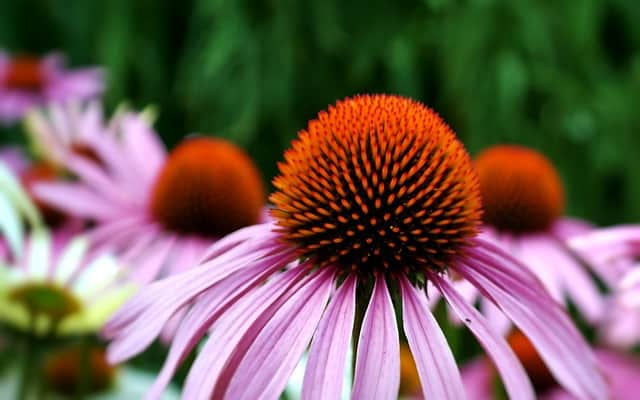
Coneflower (Echinacea) is a beloved perennial well-known for its striking, daisy-like flowers that bloom in late summer and typically persist into fall. With vibrant shades of purple, pink, white, and even orange, Coneflower adds a cheerful burst of color to any landscape. Beyond their beauty, these flowers are highly attractive to pollinators, including bees and butterflies, making them vital contributors to a healthy ecosystem in your garden.
In terms of care, Coneflowers are remarkably easy to grow. They prefer full sun and well-drained soil, thriving in a range of soil types, including poor or clay soils. Once established, these hardy plants are drought-tolerant, requiring minimal watering and care during dry spells. Their resilience extends to pest and disease resistance, which means they can withstand common garden challenges with ease.
To maintain their shape and encourage new blooms, a simple deadheading of spent flowers is beneficial, but even this is optional. Coneflowers also provide additional visual interest in the fall, as their seed heads attract birds looking for food during the cooler months. For gardeners seeking an adaptable plant that offers beauty, ecological benefits, and minimal maintenance, Coneflower is an excellent choice that shines brightly in autumn.
Densiformis Yew

Densiformis Yew (Taxus media ‘Densiformis’) is a compact, evergreen shrub that brings structure and year-round interest to gardens. With its dense foliage of dark green, needle-like leaves, this low-maintenance plant thrives in a variety of environmental conditions, making it adaptable for different gardening styles. Its rounded form lends itself beautifully to formal hedges, foundation plantings, or as an accent in mixed borders.
This yew variety prefers well-drained soil and can thrive in both full sun and partial shade, making it versatile for various planting locations. Once established, Densiformis Yew requires little maintenance beyond occasional pruning to maintain its shape. It is also resistant to many pests and diseases, allowing it to flourish with little intervention from the gardener.
The deep green color of Densiformis Yew remains consistent throughout the fall and winter months, maintaining its aesthetic appeal even as many other plants go dormant. This characteristic makes it a standout choice for creating visual continuity in landscapes through the changing seasons. Whether used as a standalone specimen or as part of a more elaborate design, Densiformis Yew embodies the essence of low-maintenance gardening while adding significant value to any autumn landscape.
Euonymus

Euonymus is another versatile and low-maintenance option for fall gardens, known for its attractive foliage and ability to thrive in a variety of conditions. There are numerous species and varieties of Euonymus, ranging from ground covers to larger shrubs, each providing unique visual interest. Many cultivars are admired for their striking variegated leaves, which can feature bright gold, green, or even purple hues. As autumn approaches, certain varieties may develop beautiful fall colors, offering even more visual delight in your garden.
Euonymus plants are highly adaptable, tolerating various soil types and moisture levels, and they can thrive in full sun to partial shade. This adaptability, along with their generally low water needs once established, positions them as ideal candidates for low-maintenance landscaping. Additionally, Euonymus is relatively pest-resistant, further enhancing its low-maintenance reputation.
In the fall, the foliage can provide a stunning backdrop for seasonal changes, and many Euonymus varieties produce colorful berries, attracting birds and other wildlife. While occasional pruning may be necessary to maintain shape and promote healthy growth, this shrub generally requires minimal intervention. With their consistent beauty and ecological contributions, Euonymus plants make a wonderful addition to any fall garden seeking low-maintenance elegance.
Hellebore
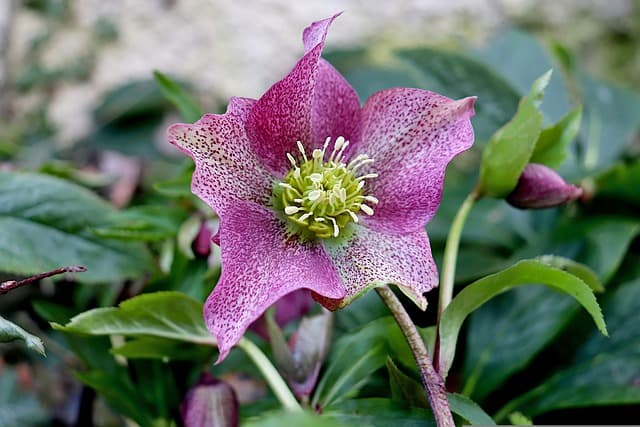
Hellebore, often referred to as the winter rose or Lenten rose, is a remarkable perennial that flourishes in the cooler months, making it a perfect fit for fall and winter gardens. Known for its charming, nodding flowers that come in an array of colors—from pale whites and soft pinks to deep purples—Hellebore blooms typically appear as early as late winter and continue through early spring, providing a welcoming garden highlight during the dormant season.
What sets Hellebore apart is its ability to thrive in shady areas, making it an ideal choice for woodland gardens or spots where other flowers may struggle. It prefers well-drained, rich soil, but is forgiving and can adapt to a range of soil types. Once established, Hellebore requires minimal watering and is drought-resistant, making it a smart choice for low-maintenance gardening.
Additionally, the leathery leaves of Hellebore offer striking texture and rich greenery, even as temperatures drop. As the flowers fade, the foliage adds structure to the garden landscape. These resilient plants are relatively pest-free, making them a low-maintenance perennial that rewards gardeners with color and interest during a time when many plants are simply biding their time until spring.
Heuchera
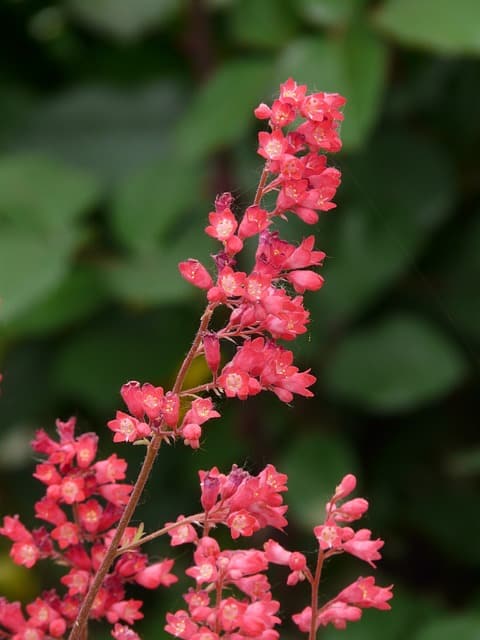
Heuchera, commonly known as Coral Bells, is a versatile perennial widely admired for its colorful foliage and delicate flower spikes. While its bell-shaped blooms add charm in the summertime, it’s the stunning foliage that takes center stage during fall, transforming from vibrant greens to rich shades of burgundy, copper, and even silver. This dramatic change not only enhances the autumn landscape but also provides a lovely contrast against the backdrop of other seasonal plants.
Heuchera thrives in well-drained soil and is tolerant of a variety of light conditions, from full sun to partial shade, making it easily adaptable to different garden settings. Once planted, these hardy perennials require little upkeep beyond the occasional watering and mulching to retain moisture. They are also quite resilient to pests and disease, ensuring a beautiful display with minimal intervention.
To keep your Heuchera plants looking their best, a simple process of trimming back dead foliage in early spring will encourage fresh new growth. The extraordinary color variations available in the many Heuchera cultivars mean that gardeners can find the perfect match for their landscapes while enjoying the benefits of a low-maintenance, visually striking plant. With their multitude of attractive hues and ease of care, Heuchera is an essential addition to any low-maintenance fall garden.
Itea
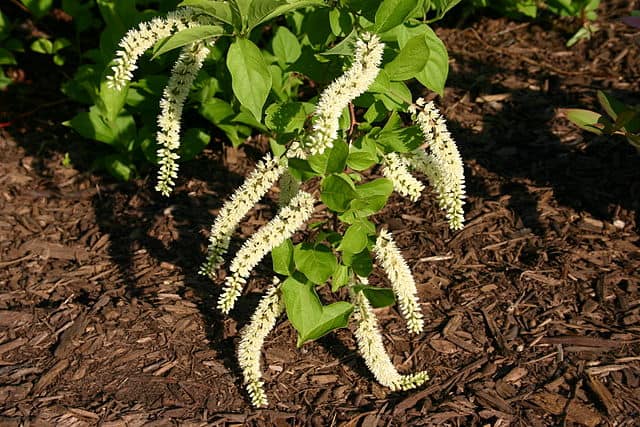
Itea, commonly known as Sweetspire, is a deciduous shrub that brings delightful texture and fragrance to the fall garden. Its arching branches are adorned with slender, lance-shaped leaves that turn striking shades of red, orange, and yellow in autumn, illuminating the landscape with a warm glow. In addition to its fall foliage, Itea produces fragrant, white, bottlebrush-like flowers in late spring to early summer that attract a variety of pollinators, making it both beautiful and beneficial for local ecosystems.
This adaptable shrub thrives in well-drained, moist soil and can flourish in both full sun and partial shade. Itea is particularly well-suited for areas with consistently wet soil, making it an excellent option for rain gardens or near water features. Once established, this resilient plant requires minimal maintenance, as it is tolerant of drought and resistant to many pests and diseases.
Pruning is infrequent, typically limited to shaping and removing any dead or damaged branches. Its natural tendency to spread and fill in an area makes Itea an ideal choice for low-maintenance hedges or borders. With its stunning seasonal transformation and resilience, Itea is a standout addition to any low-maintenance fall landscape, enriching the garden with vibrant color and delightful fragrance.
Ivory Halo Dogwood
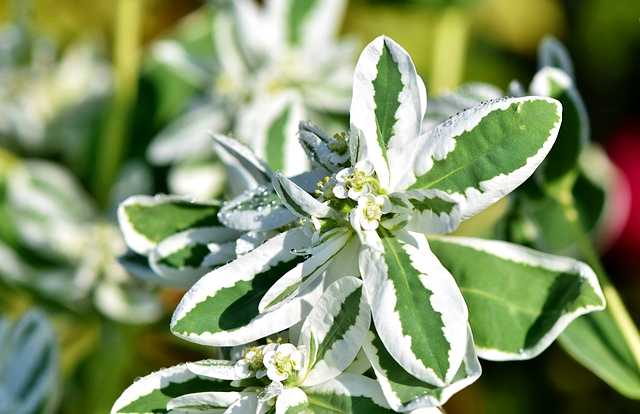
Ivory Halo Dogwood (Cornus alba ‘Ivory Halo’) is a striking shrub that provides year-round interest, with particularly captivating characteristics in the fall. This cultivar is renowned for its striking variegated leaves, featuring green edges and creamy white centers that create a lush visual contrast. As autumn approaches, the foliage transitions to a stunning display of yellow and burgundy, ensuring it catches the eye throughout the season.
One of the standout features of the Ivory Halo Dogwood is its bright red stems, which offer vibrant color even as the leaves fall and expose its stems in late autumn and winter. This unique quality makes it a fantastic choice for creating statements in the landscape. The plant thrives best in full sunlight to partial shade, and it adapts well to a variety of soil types, including clay, which means it is low-maintenance and easy to grow.
In terms of care, this hardy shrub requires occasional pruning to maintain its shape and promote healthy growth, but it’s generally very forgiving. Additionally, Ivory Halo Dogwood is resistant to many pests and diseases, making it a reliable choice for gardeners looking for a hassle-free plant. With its vibrant colors, unique features, and minimal care requirements, Ivory Halo Dogwood serves as an excellent backbone for any low-maintenance fall garden.
Kaleidoscope Abelia
Kaleidoscope Abelia (Abelia x grandiflora ‘Kaleidoscope’) is a delightful shrub that offers year-round visual impact, particularly during the fall months. This cultivar is celebrated for its variegated foliage, featuring bright golden leaves with a subtle green center that remains vibrant throughout the season. As autumn approaches, the foliage takes on rich orange and red hues, creating an eye-catching display that livens up any garden space.
This shrub is highly adaptable, thriving in full sun to partial shade and coping well with various soil types, including drought-prone areas. Kaleidoscope Abelia is incredibly low-maintenance, requiring little more than occasional watering during extended dry periods. Furthermore, this resilient plant is known for its resistance to pests and diseases, allowing for worry-free gardening.
Kaleidoscope Abelia produces small, fragrant white flowers in the summer that attract bees and butterflies, adding to its charm. Pruning is minimal; a light trim in late winter or early spring can help maintain its shape and promote fresh growth. With its spectacular color transitions, delightful fragrance, and ease of care, Kaleidoscope Abelia is an excellent option for those seeking to create a vibrant and low-maintenance fall garden.
Lamb’s Ear
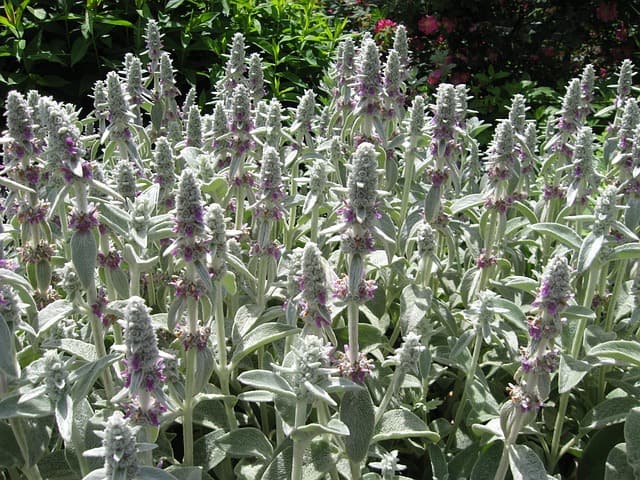
Lamb’s Ear (Stachys byzantina) is a delightful perennial known for its lush, velvety foliage that makes a striking addition to any fall garden. Characterized by its soft, fuzzy leaves resembling the ears of a lamb, this plant not only offers a unique texture but also brings a soothing, silvery-green color to borders and pathways. In autumn, while its floral display diminishes, the charming foliage remains a standout feature, complementing fall’s rich tones.
This plant thrives in full sun, which helps enhance its silvery appearance, and it appreciates well-drained soil, making it versatile enough for many garden types. Once established, Lamb’s Ear is drought-tolerant, requiring minimal watering, which makes it a perfect candidate for low-maintenance landscapes. Additionally, it is naturally resistant to pests and diseases, allowing for a carefree gardening experience.
Lamb’s Ear can also serve as an excellent ground cover due to its spreading nature, effectively suppressing weeds and filling in bare spaces in the garden. Pruning is minimal, with the occasional deadheading or trimming back in the spring to encourage new growth. With its captivating texture, resilience, and ease of care, Lamb’s Ear proves to be an exceptional choice for low-maintenance fall gardening that offers year-round appeal.
North Pole Arborvitae
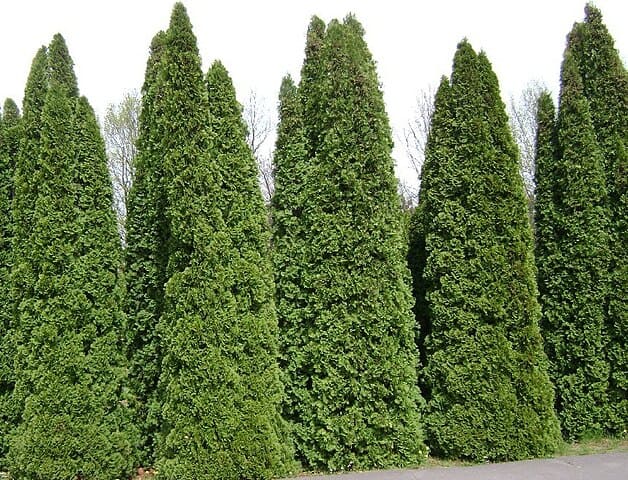
North Pole Arborvitae (Thuja occidentalis ‘North Pole’) is a narrow, upright evergreen that provides elegant structure and greenery to fall landscapes. Its densely packed, rich green foliage maintains its color throughout the colder months, ensuring your garden remains visually appealing even as many other plants fade. The conical shape of this arborvitae makes it particularly valuable for creating visual interest or adding height to garden designs while occupying minimal horizontal space.
Ideal for small gardens or as a foundation planting, North Pole Arborvitae thrives in full sun to partial shade and adapts well to various soil types, provided they are well-drained. This hardy evergreen is low-maintenance, requiring little more than occasional watering and an annual pruning to maintain its desired shape and size. Its strong resistance to pests and diseases further enhances its suitability for low-maintenance landscapes.
In the fall, North Pole Arborvitae stands out as a natural accent piece, creating a stunning backdrop for other seasonal plants. Its evergreen nature not only provides warmth to your garden during the colder months but also ensures that it complements seasonal decorations through the autumn and winter holidays. With its compact form, durability, and minimal requirements, North Pole Arborvitae is an excellent addition to any low-maintenance fall garden, lending a timeless elegance to your outdoor space.
Petchoa
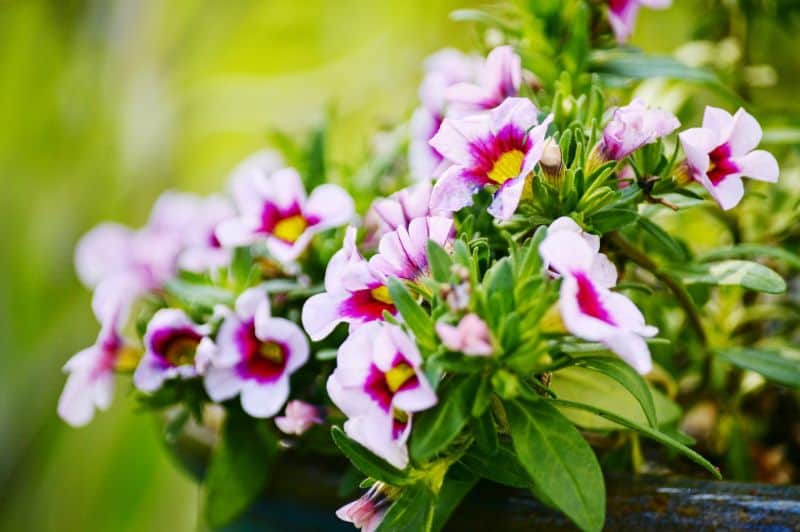
Petchoa, a hybrid between Petunia and Calibrachoa, is a standout summer annual that extends its bloom into the fall, providing a vibrant display of color when many other flowering plants begin to fade. With its range of eye-catching shades, from brilliant purples and soft pinks to striking yellows and whites, Petchoa serves as a true showstopper in garden beds, containers, and hanging baskets.
One of the most appealing features of Petchoa is its increased resilience to heat and rain compared to traditional petunias. This low-maintenance plant thrives in full sun and prefers well-drained soil, although it’s forgiving enough to tolerate some variability. Once established, Petchoa exhibits drought tolerance, meaning it requires less frequent watering, which makes it perfect for busy gardeners.
In addition to its beauty, Petchoa remains tidy and self-cleaning, meaning that dead blooms fall off naturally, preventing the need for deadheading. The rich foliage, combined with continuous flowering, keeps your garden looking fresh and colorful well into the fall season. Whether used as a ground cover or mixed with other plants in containers, Petchoa adds an inviting vibrancy to the landscape, elevating the garden’s visual appeal with minimal effort.
Rhododendron
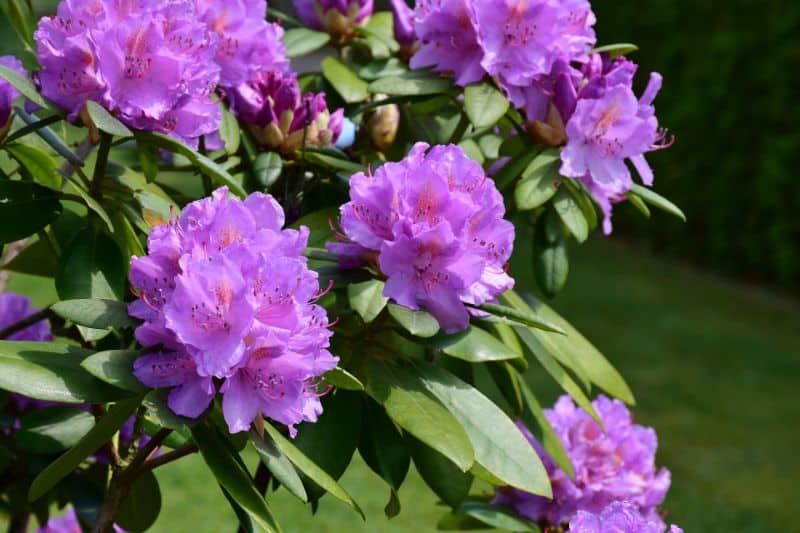
Rhododendron, particularly the evergreen varieties, is a classic and enduring choice for low-maintenance fall landscapes. Known for its lush foliage and vibrant clusters of flowers in the spring, rhododendrons also maintain their appeal throughout the autumn months. As the weather cools, their dark green leaves create contrast against fading blooms and provide a backdrop for fall colors in surrounding plants.
These shrubs thrive in partial shade to dappled sunlight, making them well-suited for woodland gardens or areas that receive filtered light. Preferring acidic, well-drained soil, rhododendrons establish deep roots, enhancing their resilience to drought conditions once established. They require minimal effort, making them a stress-free choice for gardeners looking for beauty without significant upkeep.
Rhododendrons can tolerate a variety of growing conditions but should be protected from extreme heat and strong winds. Their need for relatively little pruning means that maintenance is reduced to occasional deadheading and the removal of any dead or damaged branches. In the fall, the overall structure of rhododendrons adds depth and visual stability to the garden, while their evergreen foliage ensures a continual presence of greenery, even in winter’s chill. With their timeless beauty and adaptability, rhododendrons truly embody the spirit of low-maintenance fall plants.
Royal Purple Smoke Bush
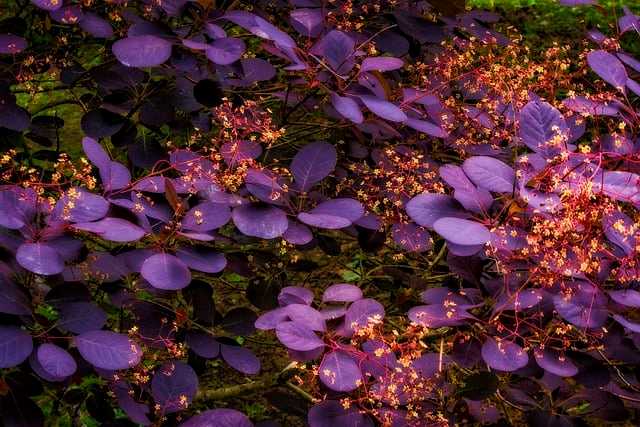
Royal Purple Smoke Bush (Cotinus coggygria ‘Royal Purple’) is a dramatic shrub that brings vibrant color and unique texture to your garden landscape throughout the fall. Renowned for its stunning purple foliage, this plant creates an eye-catching display from spring through autumn. In the fall, the leaves transition to rich red and orange hues, providing a spectacular backdrop for any autumn-themed setting. Additionally, its ethereal, plume-like flower clusters—resembling billowy clouds of smoke—add distinctive visual interest and depth to the planting space.
This hardy shrub thrives in full sun, enabling it to develop its bold color and maintain a compact, upright growth habit. Royal Purple Smoke Bush adapts well to various soil types, thriving in both well-drained and moderately dry conditions, making it particularly low-maintenance. Once established, it requires minimal watering, standing up to drought conditions without sacrificing its vitality.
Pruning is primarily limited to shaping in early spring or late winter, which encourages new growth and maintains its desired size. This shrub is also relatively pest- and disease-resistant, which further simplifies gardening efforts. With its show-stopping colors and alluring smoke-like blooms, Royal Purple Smoke Bush serves as a true centerpiece in low-maintenance fall gardens, ensuring your landscape remains captivating throughout the season.
Rugosa Rose
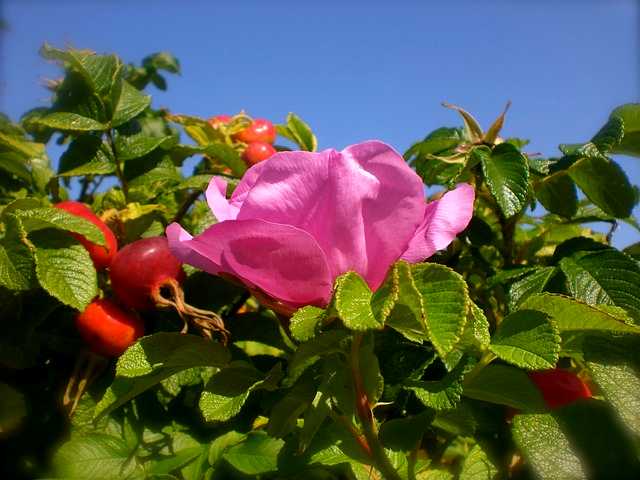
Rugosa Rose (Rosa rugosa) is an exceptional perennial that effortlessly enhances garden aesthetics while being incredibly low-maintenance. Recognized for its lush, fragrant blooms in shades of pink, white, and red, this perennial rose variety brings a delightful fragrance to your outdoor space. In the fall, the flowers give way to bright red or orange hips that not only add visual appeal but also serve as a food source for birds and small wildlife.
This hardy shrub thrives in diverse environments, demonstrating remarkable adaptability to various soil types and moisture levels. It thrives best in full sun but can tolerate partial shade, making it versatile for different garden settings. Rugosa Rose’s vigor makes it resistant to many common diseases and pests that typically affect roses, significantly reducing the need for interventions.
Another compelling feature of Rugosa Rose is its drought tolerance once established. It requires minimal watering, which is an attractive quality for gardeners who prefer low-maintenance options. Regular pruning is unnecessary; however, a light trim to remove any dead or damaged stems can enhance its overall appearance and encourage healthy growth. With its beautiful blooms, hardiness, and ability to provide wildlife habitat, Rugosa Rose is a fantastic addition to any low-maintenance fall garden, effortlessly merging beauty with functionality.
Russian Sage

Russian Sage (Perovskia atriplicifolia) stands out as a perennial that is not only remarkably attractive but also exceptionally easy to care for. Known for its striking silvery foliage and tall spikes of lavender-blue flowers, Russian Sage brings a touch of elegance and a hint of the exotic to any garden scheme. As the seasons shift into fall, the foliage retains its attractive color, while the blooming period can extend well into autumn, creating a harmonious blend of colors.
This plant thrives in full sun and is tolerant of poor, well-drained soils, making it extremely suitable for low-maintenance gardens. Russian Sage is notably drought-tolerant once established, requiring little irrigation and general upkeep. Its robust nature allows it to withstand varying weather conditions, making it a low-stress choice for gardeners everywhere.
Pruning is minimal; typically, a hard cut back in early spring will encourage fresh growth and maintain an attractive shape. Additionally, Russian Sage is rarely troubled by pests or diseases, further simplifying care. In the autumn, its striking vertical growth and subtle, fragrant flowers can provide texture and movement in your landscape, beautifully complementing nearby foliage. This combination of endurance, beauty, and ease of care makes Russian Sage an indispensable choice for those looking to cultivate a low-maintenance fall garden that captivates the eye.
Sea Holly
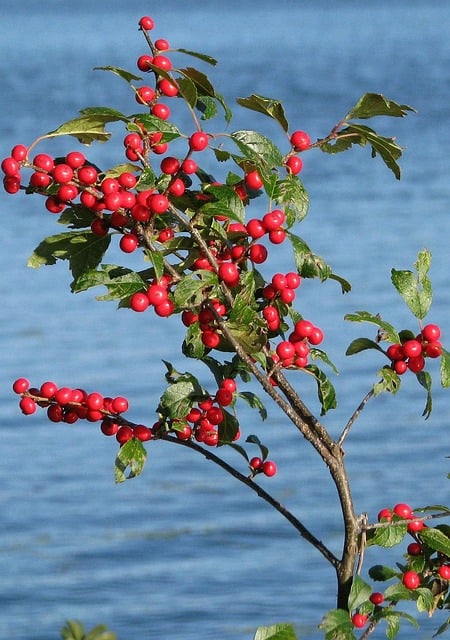
Sea Holly (Eryngium spp.) is a striking perennial that makes a bold statement in the garden with its unique architectural form and vibrant colors. This plant is notable for its spiky, thistle-like flowers and silvery-blue foliage, providing an eye-catching contrast to traditional fall blooms. The blooms emerge in late summer and persist into the fall, attracting pollinators such as bees and butterflies, making it an excellent choice for wildlife-friendly gardens.
Adapting well to a variety of soil types, Sea Holly thrives in well-drained conditions and is particularly drought-tolerant, requiring little additional watering once established. It enjoys full sun exposure, which enhances its color and promotes healthy growth. Unlike many other perennials, Sea Holly does not require frequent division, reducing maintenance needs and making it a truly low-effort option.
Another appealing factor is its resistance to rabbits and deer, making it a reliable choice for those who live in areas with wildlife pressures. The plant’s dried seed heads also offer year-round interest, providing a sculptural element to the winter landscape. With its dazzling beauty and easy-care nature, Sea Holly is a fantastic addition to any low-maintenance fall garden, effortlessly blending aesthetics with practicality.
Sedum

Sedum, often referred to as stonecrop, encompasses a diverse range of succulent plants known for their fleshy leaves and vibrant blooms. Among these, varieties like Sedum ‘Autumn Joy’ and Sedum spurium shine during the fall season, producing clusters of star-shaped flowers in shades of pink, red, and amber that create a stunning display. The foliage typically adopts a rich, warm hue in autumn, enhancing the overall appeal of the landscape.
This hardy genus thrives in well-drained soils and prefers full sun, making it an excellent choice for rocky gardens, slopes, or dry spots in the landscape. Once established, Sedum is incredibly drought-tolerant, requiring minimal watering, which makes it ideal for low-maintenance gardens. Its resilient nature allows it to flourish with little attention, surviving in conditions that would challenge other plants.
Sedum is also prized for its ability to attract pollinators, adding life and vibrancy to your garden ecosystem. In addition, it can be used as ground cover, effectively suppressing weeds and stabilizing soils in sunny areas. Maintenance involves little more than removing deadheads in early spring to promote new growth. With its striking blooms, unique textures, and easy-care attributes, Sedum stands out as a must-have for any low-maintenance fall garden.
Serviceberry
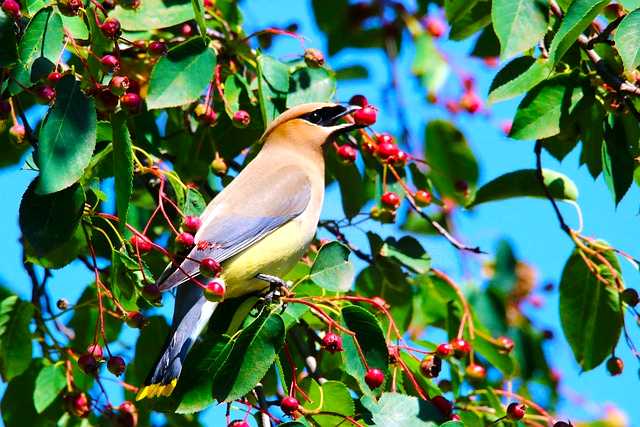
Serviceberry (Amelanchier spp.) is a versatile, deciduous shrub that offers a fantastic blend of beauty, edibility, and resilience. This native plant is renowned for its stunning white blossoms in early spring, which transition to small, sweet berries in summer and vibrant red and gold foliage in fall. As the leaves change, Serviceberry transforms the landscape into a rich tapestry of colors, making it a true gem for autumn gardens.
Serviceberry thrives in mixed environments, adapting to a variety of soil types, including clay, loam, and sandy soils, provided they are well-drained. Preferring partial shade to full sun, it is easy to incorporate into many garden designs. Once established, this shrub is drought-tolerant, requiring little watering beyond its initial establishment, thus aligning perfectly with low-maintenance gardening principles.
In addition to its visual appeal, Serviceberry serves multiple ecological roles by providing habitat and food for birds, butterflies, and other wildlife. The berries are edible and can be enjoyed fresh or used in jams and desserts, adding both culinary value and wildlife attraction to your garden. Minimal maintenance is required; a light pruning in late winter or early spring will help maintain its shape and promote healthy growth. With its beautiful seasonal changes, edibility, and ease of care, Serviceberry is an excellent addition to any low-maintenance fall garden, offering both beauty and benefits year-round.
Summersweet

Summersweet (Clethra alnifolia), commonly known as sweet pepperbush, is a versatile and fragrant shrub that adds both visual appeal and sensory delight to your garden. Blooms in late summer to early fall produce spikes of white or pink flowers that are not only beautiful but also possess a sweet, alluring fragrance that attracts hummingbirds and butterflies, thus enhancing biodiversity in your garden.
This adaptable shrub thrives in a variety of soil types, including moist, clay, or sandy soils, making it an excellent choice for wetter areas or beside water features. Summersweet performs best in partial shade but can adapt to full sun conditions, where it often flourishes. Once established, it requires little care beyond occasional watering during extended dry spells, allowing you to enjoy its beauty without much intervention.
Additionally, Summersweet’s foliage transitions to lovely shades of yellow in the fall, adding another layer of interest to your autumn landscape. Minimal pruning is necessary, typically limited to removing spent flowers or any dead wood, which keeps the shrub tidy. With its enchanting fragrance, lovely blooms, and ease of care, Summersweet is an ideal low-maintenance choice for gardeners looking to enrich their fall gardens with aromatic charm and visual beauty.
Sweet Woodruff
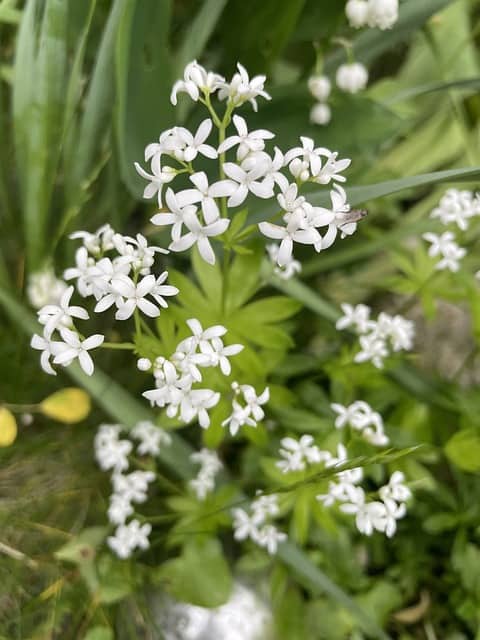
Sweet Woodruff (Galium odoratum) is a delightful ground cover that excels in shaded to partially shaded areas, making it a perfect fit for woodland gardens or under trees. Renowned for its lush, green foliage and delicate white star-shaped flowers, Sweet Woodruff adds a soft, carpet-like appearance to the garden floor. In the fall, its early-season foliage often takes on a rich, golden hue, enhancing the visual appeal of your landscape.
This perennial is a champion of low-maintenance gardening, thriving in a variety of soil types while preferring moisture-retentive, well-drained soils. Once established, Sweet Woodruff is remarkably drought-tolerant and requires minimal watering. It spreads easily yet is manageable, making it an effective choice for suppressing weeds and filling in bare patches without overwhelming other plants.
Beyond its aesthetic benefits, Sweet Woodruff is also known for its subtle fragrance, which becomes particularly pronounced when the leaves are crushed. This aromatic property has made it a traditional herb for potpourri and cooking in certain cultures. Minimal maintenance involves occasional division to control spreading, while light trimming can help maintain its shape. With its charming appearance, delightful fragrance, and ease of care, Sweet Woodruff is an excellent addition to any low-maintenance fall garden.
Iris
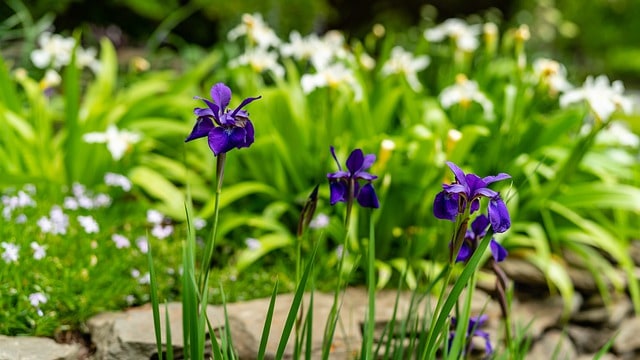
Iris (Iris pallida ‘Variegata’) is a striking perennial that brings vibrant color and texture to your fall garden. Characterized by its beautiful, sword-like leaves that boast creamy white margins, this plant creates a dynamic visual contrast in any garden bed. While the Variegated Iris typically blooms in late spring to early summer, its foliage remains attractive throughout the fall, adding interest as other plants lose their leaves.
One of the most appealing aspects of Variegated Iris is its adaptability to various soil types, although it thrives best in well-drained, moderately moist soils. This plant enjoys full sun to partial shade, making it a versatile choice for different planting situations. Once established, Variegated Iris requires minimal watering, easily resisting periods of drought, which aligns perfectly with a low-maintenance garden philosophy.
Moreover, it is relatively disease-resistant and attracts beneficial pollinators without the hassle of extensive care. Minimal maintenance is required; simply deadhead spent blooms to encourage tidy growth. With its eye-catching foliage and ease of care, Variegated Iris enhances the aesthetic of any low-maintenance fall garden while standing as a testament to the beauty of simplicity in plant selection.
Solomon’s Seal
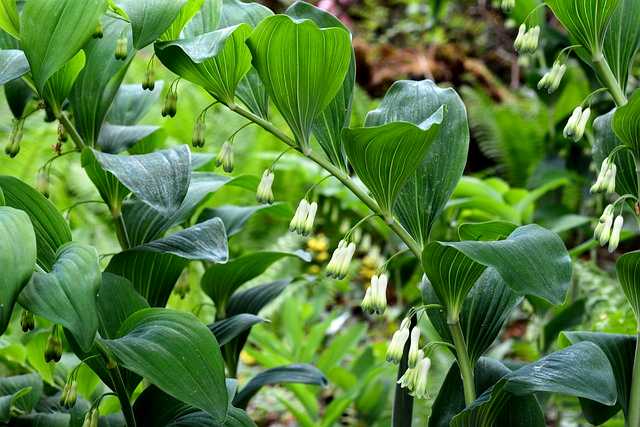
Solomon’s Seal (Polygonatum odoratum ‘Variegatum’) is another exquisite choice for the low-maintenance fall garden. This perennial is prized for its unique arching stems and stunning white, creamy variegated leaves that elegantly brighten shaded areas. In the late spring, it produces delicate, bell-shaped flowers that offer a subtle yet enchanting fragrance, further enriching the sensory experience of your outdoor space.
Thriving in partial to full shade, Variegated Solomon’s Seal is an excellent option for woodland gardens or as a groundcover beneath trees. It prefers rich, well-drained soil and can tolerate a variety of conditions, making it exceptionally versatile. Once established, this plant requires little water, showcasing its resilience during dryer periods, which is ideal for gardeners seeking less intensive upkeep.
Beyond its beauty, this plant exhibits excellent pest resistance, with few issues arising from insects or diseases. The only maintenance required is the occasional removal of spent foliage in late fall to keep the area tidy. Variegated Solomon’s Seal not only adds an elegant touch to any garden but also exemplifies easy-care gardening, making it a fantastic addition to your collection of low-maintenance fall plants.
Violas
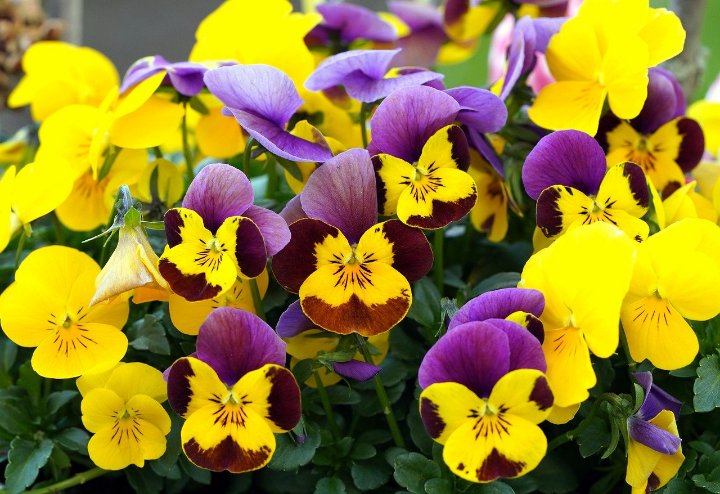
Violas (Viola spp.) are charming, hardy annuals that provide cheery splashes of color throughout the fall and beyond. With an array of vibrant hues from deep purples and blues to yellows and whites, these petite flowers create a delightful display that can easily lift the spirits of any garden landscape. Violas bloom profusely, often continuing to flower even through light frost, making them perfect for extending the gardening season.
Violas thrive in rich, well-drained soil and prefer full sun to light shade. Once established, they require minimal maintenance. Regular deadheading ensures continuous blooming and a tidy appearance in your garden beds. These plants are also notable for their ability to self-seed, allowing for new plants to emerge with little effort on your part.
Furthermore, Violas are adaptable, flourishing in both garden beds and containers, making them versatile for any type of garden design. They are also relatively pest-resistant and can handle varying weather conditions, making them an ideal low-maintenance option. With their cheerful blooms and effortless care, Violas enhance the aesthetic of any low-maintenance fall garden while offering a burst of color that lasts.


